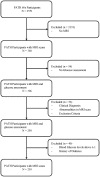High "normal" blood glucose is associated with decreased brain volume and cognitive performance in the 60s: the PATH through life study
- PMID: 24023897
- PMCID: PMC3762736
- DOI: 10.1371/journal.pone.0073697
High "normal" blood glucose is associated with decreased brain volume and cognitive performance in the 60s: the PATH through life study
Abstract
Context: Type 2 diabetes is associated with cerebral atrophy, cognitive impairment and dementia. We recently showed higher glucose levels in the normal range not to be free of adverse effects and to be associated with greater hippocampal and amygdalar atrophy in older community-dwelling individuals free of diabetes.
Objective: This study aimed to determine whether blood glucose levels in the normal range (<6.1 mmol/L) were associated with cerebral volumes in structures other than the hippocampus and amygdale, and whether these glucose-related regional volumes were associated with cognitive performance.
Design setting and participants: 210 cognitively healthy individuals (68-73 years) without diabetes, glucose intolerance or metabolic syndrome were assessed in the large, community-based Personality and Total Health Through Life (PATH) study.
Main outcome measure: Baseline blood glucose levels in the normal range (3.2-6.1 mmol/l) were used to determine regional brain volumes and associated cognitive function at wave 3.
Results: Higher blood glucose levels in the normal range were associated with lower grey/white matter regional volumes in the frontal cortices (middle frontal gyrus, inferior frontal gyrus precentral gyrus). Moreover, identified cerebral regions were associated with poorer cognitive performance and the structure-function associations were gender specific to men.
Conclusion: These findings stress the need to re-evaluate what is considered as healthy blood glucose levels, and consider the role of higher normal blood glucose as a risk factor for cerebral health, cognitive function and dementia. A better lifetime management of blood glucose levels may contribute to improved cerebral and cognitive health in later life and possibly protect against dementia.
Conflict of interest statement
Figures
References
-
- Manschot SM, Brands AM, van der Grond J, Kessels RP, Algra A, et al. (2006) Brain magnetic resonance imaging correlates of impaired cognition in patients with type 2 diabetes. Diabetes 55: 1106–1113. - PubMed
-
- DeVisser A, Yang C, Herring A, Martinez JA, Rosales-Hernandez A, et al. (2011) Differential impact of diabetes and hypertension in the brain: adverse effects in grey matter. Neurobiol Dis 44: 161–173. - PubMed
-
- den Heijer T, Vermeer SE, van Dijk EJ, Prins ND, Koudstaal PJ, et al. (2003) Type 2 diabetes and atrophy of medial temporal lobe structures on brain MRI. Diabetologia 46: 1604–1610. - PubMed
-
- Araki Y, Nomura M, Tanaka H, Yamamoto H, Yamamoto T, et al. (1994) MRI of the brain in diabetes mellitus. Neuroradiology 36: 101–103. - PubMed
-
- Vermeer SE, Den Heijer T, Koudstaal PJ, Oudkerk M, Hofman A, et al. (2003) Incidence and risk factors of silent brain infarcts in the population-based Rotterdam Scan Study. Stroke 34: 392–396. - PubMed
Publication types
MeSH terms
Substances
LinkOut - more resources
Full Text Sources
Other Literature Sources
Medical



